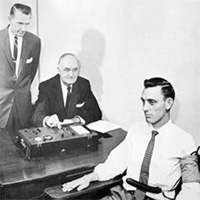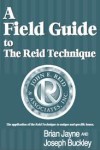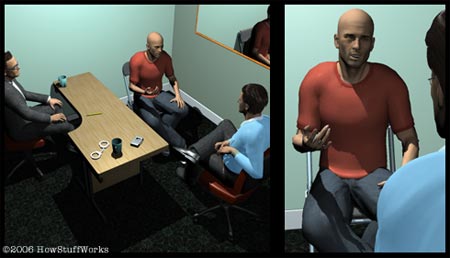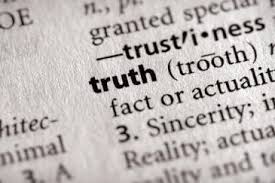 The psychology of effective police interrogation is complex. Today’s interrogators train in communication, human behavioural science, and legal procedures. They hone their skills through years of practice. But regardless of how smooth-talking a detective may be, the secret to success in securing admissible confessions will always lie in being a good listener, mentally manipulating the suspect, and using common sense.
The psychology of effective police interrogation is complex. Today’s interrogators train in communication, human behavioural science, and legal procedures. They hone their skills through years of practice. But regardless of how smooth-talking a detective may be, the secret to success in securing admissible confessions will always lie in being a good listener, mentally manipulating the suspect, and using common sense.
 In my years as a homicide investigator and dealing with suspects, I’ve worked with excellent interrogators. RCMP Polygraphist Don Adam was one of the best. Don was a natural in getting suspects to talk. I was fortunate to learn from guys like Don in mastering techniques that got confessions that’d stick in court. There’s a point where natural talent and learned techniques intertwine. That produces a good interrogator who produces good evidence.
In my years as a homicide investigator and dealing with suspects, I’ve worked with excellent interrogators. RCMP Polygraphist Don Adam was one of the best. Don was a natural in getting suspects to talk. I was fortunate to learn from guys like Don in mastering techniques that got confessions that’d stick in court. There’s a point where natural talent and learned techniques intertwine. That produces a good interrogator who produces good evidence.
Courts in the civilized world have a basic criteria for admitting confessions from accused persons as evidence. This pertains to statements made to persons in authority, ie – cops:
- Statements must be voluntary. Suspects can’t be threatened in any way or promised a favor in return for talking.
- Suspects must be aware of their legal rights and waive an opportunity to exercise them.
- Their rights are to remain silent and to consult a lawyer, if they choose.
 The reasons for these strict rules are to avoid the chance of false confessions being used to convict people and ensuring an ethical theater in law enforcement. Interrogations are usually done in an accusatory, guilt presumptive process and not in an objective environment. So they begin with a definite bias – not like a court proceeding which operates with a presumption of innocence.
The reasons for these strict rules are to avoid the chance of false confessions being used to convict people and ensuring an ethical theater in law enforcement. Interrogations are usually done in an accusatory, guilt presumptive process and not in an objective environment. So they begin with a definite bias – not like a court proceeding which operates with a presumption of innocence.
It’s also vitally important that confessions to crimes be corroborated in some way that verifies their truthfulness. Corroboration means backing up the confession with some form of evidence that proves the subject is being truthful and not elicited into making a false confession. Examples of corroboration are turning over a murder weapon, directing investigators to the location of a hidden body or divulging some key fact(s) known only to the perpetrator and the investigators. Corroboration is a must in verifying truthfulness and avoiding the chance of false confessions being used to convict an accused.
I’ve seen a lot of unscientific techniques applied in interrogations. The oldest one is the good cop – bad cop thing. Sometimes it works. Sometimes it backfires. Buddy-buddying the suspect only succeeds if there’s common ground. Minimization – Maximization. Cat & mouse. Outright deception to a subject is dangerous. If the interrogator is caught lying – it’s pretty much over. Torture – mental or physical – is completely unacceptable and would probably end with the cop in jail.
So what’s the best interrogation procedure?
 Well, it’s been around for a long time since an American polygraphist by the name of John E. Reid figured out a 9 Step formula of psychological manipulation which is known as the Reid Technique.
Well, it’s been around for a long time since an American polygraphist by the name of John E. Reid figured out a 9 Step formula of psychological manipulation which is known as the Reid Technique.
The basic premise of interrogation is to manipulate the suspect into talking and then listen to what they’re saying. Once they start talking, it’s hard for them to stop. Once they start telling the truth, it’s harder to continue lying.
In the Reid Technique, interrogation is an accusatory process where the interrogator opens by telling the suspect that there’s no doubt about their guilt. The interrogator delivers a monologue rather than a question and answer format and the composure is understanding, patient, and non-demeaning. The goal is making the suspect progressively more and more comfortable with acknowledging the truth about what they’ve done. This is accomplished by the interrogator first imagining and then offering the subject various psychological constructs as justification for their behavior.
 For example, an admission of guilt might be prompted by the question, “Did you plan this out or did it just happen on the spur of the moment?” This technique uses a loaded question that contains the unspoken, implicit assumption of guilt. The idea is that the suspect must catch the hidden assumption and contest it to avoid the trap.
For example, an admission of guilt might be prompted by the question, “Did you plan this out or did it just happen on the spur of the moment?” This technique uses a loaded question that contains the unspoken, implicit assumption of guilt. The idea is that the suspect must catch the hidden assumption and contest it to avoid the trap.
But the psychological manipulation begins before the interrogator even opens his mouth, though.
The physical layout of an interrogation room is designed to maximize a suspect’s discomfort and sense of powerlessness from the moment they step inside. The classic interrogation manual Criminal Interrogation and Confessions, which was co-written by John Reid, recommends a small, soundproof room with only two or three chairs, a desk, and nothing on the walls. This creates a sense of exposure, unfamiliarity, and isolation. It heightens the suspect’s “get me out of here” sensation throughout the interrogation.
 The manual also suggests that the suspect should be seated in an uncomfortable chair, out of reach of any controls like light switches or thermostats, furthering his discomfort and setting up a feeling of dependence. A one-way mirror and/or closed circuit TV are great additions to the room, because they increases the suspect’s anxiety and allows other interrogators to watch the process and help the principle interrogator figure out which techniques are working and which aren’t.
The manual also suggests that the suspect should be seated in an uncomfortable chair, out of reach of any controls like light switches or thermostats, furthering his discomfort and setting up a feeling of dependence. A one-way mirror and/or closed circuit TV are great additions to the room, because they increases the suspect’s anxiety and allows other interrogators to watch the process and help the principle interrogator figure out which techniques are working and which aren’t.
Before the 9 Steps of the Reid Technique begin, there’s an initial interview to determine guilt or innocence. During this time, the interrogator attempts to develop a rapport with the suspect, using casual conversation to create a non-threatening atmosphere. People tend to like and trust people who are like them, so the interrogator may claim to share some of the suspect’s interests or beliefs. If the suspect starts talking to the interrogator about harmless things, it becomes harder to stop talking or start lying later when the discussion turns to the crime.
 During this initial conversation, the interrogator observes the suspect’s reactions, both verbal and non-verbal, to establish a baseline reaction before the real stress begins. The interrogator will later use this baseline as a control or comparison point. One method of creating a baseline involves asking questions that cause the suspect to access different parts of their brain.
During this initial conversation, the interrogator observes the suspect’s reactions, both verbal and non-verbal, to establish a baseline reaction before the real stress begins. The interrogator will later use this baseline as a control or comparison point. One method of creating a baseline involves asking questions that cause the suspect to access different parts of their brain.
Non-threatening questions are asked that require memory (simple recall) and questions that require thinking (creativity). When the suspect is remembering something, their eyes often move to the right. This is an outward manifestation of their brain activating the memory center. When they’re thinking about something, the eyes will move upward or to the left, reflecting activation of the cognitive center. A trained, experienced interrogator makes a mental note of the suspect’s eye activity.
The next step is turning to the question at hand.
 The interrogator asks basic questions about the crime and compares the suspect’s reactions to the baseline. This is quite an accurate determination if the suspect is truthful or deceptive. For example, if the interrogator asks the suspect where they were the night of the crime and they answer truthfully, they’ll honestly be remembering so their eyes will move to the right. If they’re concocting an alibi, they’re thinking, so the eyes will go up or to the left. If the interrogator determines that the suspect’s reactions indicate deception and all other evidence points to guilt, then a structured interrogation of the suspect begins.
The interrogator asks basic questions about the crime and compares the suspect’s reactions to the baseline. This is quite an accurate determination if the suspect is truthful or deceptive. For example, if the interrogator asks the suspect where they were the night of the crime and they answer truthfully, they’ll honestly be remembering so their eyes will move to the right. If they’re concocting an alibi, they’re thinking, so the eyes will go up or to the left. If the interrogator determines that the suspect’s reactions indicate deception and all other evidence points to guilt, then a structured interrogation of the suspect begins.
The Reid Technique lays out a proven blueprint of 9 Steps or issues guiding an interrogation. Many of these steps overlap and there is no such thing as a “typical” interrogation. Here’s how it should go.
1.Confrontation
 The interrogator presents the facts of the case and informs the suspect of the evidence against them implying in a confident manner that the suspect is involved in the crime. The suspect’s stress level increases and the interrogator may move around the room, invading the suspect’s personal space to increase the discomfort. If the suspect starts fidgeting, licking lips, and/or grooming themselves (running his hand through their hair, for instance), the interrogator notes these as deception indicators confirming their on the right track.
The interrogator presents the facts of the case and informs the suspect of the evidence against them implying in a confident manner that the suspect is involved in the crime. The suspect’s stress level increases and the interrogator may move around the room, invading the suspect’s personal space to increase the discomfort. If the suspect starts fidgeting, licking lips, and/or grooming themselves (running his hand through their hair, for instance), the interrogator notes these as deception indicators confirming their on the right track.
2. Theme Development
The interrogator creates a story about why the suspect committed the crime. Theme development is about looking through the eyes of the suspect to figure out why they did it. The interrogator lays out a theme or a story that the suspect can latch on to in order to either excuse or justify their part in the crime and the interrogator observes the suspect to see if they’re buying the theme. Are they paying closer attention than before? Nodding their head? If so, the interrogator will continue developing that theme; if not, they’ll pick a new theme and start over. Theme development is in the background throughout the interrogation. When developing themes, the interrogator speaks in a soft, soothing voice to appear non-threatening and to lull the suspect into a false sense of security.
3. Stopping Denials
 Letting the suspect deny their guilt will increase their confidence, so the interrogator tries to interrupt all denials, sometimes telling the suspect it’ll be their turn to talk in a moment, but right now, they need to listen. From the start of the interrogation, the interrogator watches for denials and stops the suspect before they can voice them. In addition to keeping the suspect’s confidence low, stopping denials also helps quiet the suspect so they don’t have a chance to ask for a lawyer. If there are no denials during theme development, the interrogator takes this as a positive indicator of guilt. If initial attempts at denial slow down or stop during theme development, the interrogator knows they’ve found a good theme and that the suspect is getting closer to confessing.
Letting the suspect deny their guilt will increase their confidence, so the interrogator tries to interrupt all denials, sometimes telling the suspect it’ll be their turn to talk in a moment, but right now, they need to listen. From the start of the interrogation, the interrogator watches for denials and stops the suspect before they can voice them. In addition to keeping the suspect’s confidence low, stopping denials also helps quiet the suspect so they don’t have a chance to ask for a lawyer. If there are no denials during theme development, the interrogator takes this as a positive indicator of guilt. If initial attempts at denial slow down or stop during theme development, the interrogator knows they’ve found a good theme and that the suspect is getting closer to confessing.
4. Overcoming Objections
Once the interrogator has fully developed a theme that the suspect relates to, the suspect may offer logic-based objections as opposed to simple denials, like “I could never rape somebody — my sister was raped and I saw how much pain it caused. I would never do that to someone.” The interrogator handles these differently than denials because these objections can give information to turn around and use against the suspect. The interrogator might say something like, “See, that’s good, you’re telling me you would never plan this, that it was out of your control. You care about women like your sister — it was just a one-time mistake, not a recurring thing.” If the interrogator does his job right, an objection ends up looking more like an admission of guilt.
5. Getting Suspect’s Attention
 At this point, the suspect should be frustrated and unsure of themselves. They may be looking for someone to help him escape the situation. The interrogator tries to capitalize on that insecurity by pretending to be the suspect’s ally. They’ll try to appear even more sincere in their continued theme development and may get physically closer to the suspect, making it harder for the suspect to detach from the situation. The interrogator may offer physical gestures of camaraderie and concern, such as touching the suspect’s shoulder or patting his back.
At this point, the suspect should be frustrated and unsure of themselves. They may be looking for someone to help him escape the situation. The interrogator tries to capitalize on that insecurity by pretending to be the suspect’s ally. They’ll try to appear even more sincere in their continued theme development and may get physically closer to the suspect, making it harder for the suspect to detach from the situation. The interrogator may offer physical gestures of camaraderie and concern, such as touching the suspect’s shoulder or patting his back.
6. Suspect Looses Resolve
If the suspect’s body language indicates surrender – head in his hands, elbows on knees, shoulders hunched — the interrogator seizes the opportunity to start leading the suspect into confession. It transitions from theme development to motive alternatives that force the suspect to choose a reason why they committed the crime. At this stage, the interrogator makes every effort to establish eye contact with the suspect to increase the suspect’s stress level and desire to escape. If, at this point, the suspect cries, the interrogator knows it’s a positive indicator of guilt.
7. Alternatives
 The interrogator offers two contrasting motives for some aspect of the crime, sometimes beginning with a minor aspect so it’s less threatening to the suspect. One alternative is socially acceptable (“It was a crime of passion”), and the other is morally repugnant (“You killed her for the money”). The interrogator builds up the contrast between the two alternatives until the suspect gives an indicator of choosing one, like a nod of the head or increased signs of surrender. Then, the interrogator speeds things up.
The interrogator offers two contrasting motives for some aspect of the crime, sometimes beginning with a minor aspect so it’s less threatening to the suspect. One alternative is socially acceptable (“It was a crime of passion”), and the other is morally repugnant (“You killed her for the money”). The interrogator builds up the contrast between the two alternatives until the suspect gives an indicator of choosing one, like a nod of the head or increased signs of surrender. Then, the interrogator speeds things up.
8. Bringing Suspect Into Conversation
Once the suspect chooses an alternative, the confession has begun. The interrogator encourages the suspect to talk about the crime and might arrange for a second interrogator in room to increase the suspect’s stress level and his desire to give up and tell the truth. A new person into the room also forces the suspect to reassert his socially acceptable reason for the crime, reinforcing the idea that the confession is a done deal.
9. The Confession
 The final stage of an interrogation is all about getting a truthful confession that will be admitted as evidence at trial. Virtually all interrogations today are recorded on audio/visual and transcripts are developed. There are further evidentiary tools used during confession besides words. Having the suspect draw maps or sketches of the scene, confess to secondary parties, write letters of apology, and returning the suspect back to the scene and re-enact the crime are commonly used. It’s vitally important to back-up the truthfulness of the confession with independent, corroborating evidence such as disclosing ‘key facts’ of the crime which would only be known to the perpetrator and investigators, or turning over critically implicating evidence like the murder weapon.
The final stage of an interrogation is all about getting a truthful confession that will be admitted as evidence at trial. Virtually all interrogations today are recorded on audio/visual and transcripts are developed. There are further evidentiary tools used during confession besides words. Having the suspect draw maps or sketches of the scene, confess to secondary parties, write letters of apology, and returning the suspect back to the scene and re-enact the crime are commonly used. It’s vitally important to back-up the truthfulness of the confession with independent, corroborating evidence such as disclosing ‘key facts’ of the crime which would only be known to the perpetrator and investigators, or turning over critically implicating evidence like the murder weapon.
 These steps represent some of the psychological techniques that interrogators use to get confessions from suspects, but real interrogations don’t always follow the textbook.
These steps represent some of the psychological techniques that interrogators use to get confessions from suspects, but real interrogations don’t always follow the textbook.
 Critics of the Reid Technique claim that it too easily produces false confessions, especially with young people. The use of the Reid Technique on youths is prohibited in several European countries because of the incidence of false confessions and wrongful convictions that result.
Critics of the Reid Technique claim that it too easily produces false confessions, especially with young people. The use of the Reid Technique on youths is prohibited in several European countries because of the incidence of false confessions and wrongful convictions that result.
Although it’s widely used and accepted in the USA, the Canadian courts are careful in admissibility of confessions extracted in this method, ruling that “stripped to its bare essentials, the Reid Technique is a guilt-presumptive, confrontational, psychologically manipulative procedure whose purpose is to extract a confession, not necessarily a truthful confession.” John E. Reid and Associates, the Chicago firm that holds rights to the technique and its teachings maintains that “it’s not the technique that causes false or coerced confessions, but police detectives who apply improper interrogation procedures.”
I’ve seen the Reid Technique put into practice many times with great success.
 The best example of a textbook Reid Technique interrogation is the case of Colonel Russell Williams, a Canadian Air Force commander who confessed to two sex-murders. The interrogator was Detective Sergeant Jim Smyth of the Ontario Provincial Police’s Behavioral Science Unit. The skill employed by Det. Sgt. Smyth is nothing short of magic. Smyth made sure this confession’s truthfulness was verified.
The best example of a textbook Reid Technique interrogation is the case of Colonel Russell Williams, a Canadian Air Force commander who confessed to two sex-murders. The interrogator was Detective Sergeant Jim Smyth of the Ontario Provincial Police’s Behavioral Science Unit. The skill employed by Det. Sgt. Smyth is nothing short of magic. Smyth made sure this confession’s truthfulness was verified.



Hey Gerry, murderer here, just wondering if you would agree with the claim that successful application of the Reid Technique relies -at least in some part- on the interrogator’s intuitive ability to detect deception (through verbal and non-verbal cues)? If so, how can one distinguish from deception and a general anxiety response.
Hi Ashton. Thanks for reading this piece and responding with a well-thought-out point. I completely agree the interrogator’s intuitive ability to detect deception – their built-in BS detector – plays a top role in successfully utilizing many of the steps in the Reid Technique. The technique isn’t a rigid structure that plays off a checksheet. Rather, it’s the interrogator recognizing deceptive signs and capitalizing on them as they occur. For sure, anxiety can look like deception, and it’s an individual case basis where no two situations are exactly alike. This is where the interrogator’s skill, experience and, yes, intuition comes into play.
I want to clarify something here for other readers. This post gets a lot of traffic – probably 15 to 20 hits per day – and I get some really ignorant and ill-informed comments which I normally send to the spam box. The Reid Technique isn’t perfect, by any means, and it can lead to false confessions if the interrogator isn’t properly trained and experienced with this suggestive method of truth-seeking. The empirical thing – and I can’t stress it enough (whether it’s a true Reid approach or other interrogation technique) – is that any confession MUST be corroborated in some way that proves the statement is truthful, regardless of how it was obtained.
Corroboration can come in many forms, and it’s also a case-by-case situation. By corroborating and proving the truthfulness of a confession, the legal system has solid assurance that they won’t be dealing with a false confession that was forced from an innocent person.
Hey Gerry, thanks for the urgent response! I’m terribly sorry that you have been getting hate mail, I’m skeptical of the Reid Technique (over other techniques) myself but I think it a real shame of our times that people feel the need to express crudeness when they feel they are correct.
Obviously an officer’s intuition is important but do you think there is any credence to the claim that the Reid Technique may compromise officer’s intuition (beyond other techniques).
No, I don’t think there’s any serious basis to that concern. I think most, if not all, officers who have the opportunity to use the Reid Technique are experienced interviewers who are fully aware of how it applies and do their best to remain objective. I think the fear of the Reid Technique is overblown by those who have unreasonable left-leaning civil rights views and a deep distrust of authority.
Hi Garry, I’d agree that there appears to be an anti-police sentiment among the far-left/anti-right (especially on university settings) that is particularly troublesome. I’m glad to hear someone with experience speak a counterpoint on that front.
Do you think there is any prejudicial risk of the more confrontational approach of Reid that officers ought to be aware of (beyond any absolute or fully compromising risk)?
Are there approaches other than Reid that you would be more skeptical of (e.g. PEACE), if so why?
For sure that some folks don’t like the cops. I don’t know if you picked up in previous comments on this thread where a university professor took a run at me. He actually organized a campaign with about ten students to bombard me with ignorant and defamatory comments. If he had half a brain, he’d have realized I have approval rights on my comments so I hit “spam” to all. He just wasted a large amount of their study time for his personal agenda and made them look like non-thinking sheep.
I don’t think there’s any prejudicial risk to be concerned about as long as the interviewer/interrogator is competent. It’s all about truth seeking. However, in my opinion it’s unethical, unprofessional and downright dangerous for a person in authority to outright lie to a subject/suspect. Taking that a bit further into the Reid Technique, the person in the chair with wheels on it has to be very careful about suggesting something that isn’t truthful. In the court’s eyes, it’s all about credibility, reliability and admissibility.
Other approaches that had their place are the good cop/bad cop thing and the pink bunny suit. Those days are mostly gone as there’s no way today’s western courts would allow a statement into evidence that had been coerced or muscled out of someone. I’m well aware of the PEACE technique which has it’s place for soft subjects. PEACE is really a partial REID approach and a good interviewer/interrogator will be fluid enough to work around both methods. The thing that usually worked for me was being pleasant and straightforward but immediately calling someone when I knew they were deceitful. You have to stop denials and lead into admissions with guilty subjects and that can be a lot harder to accomplish than it sounds.
There is no doubt the Reid Technique is highly effective at “getting to the bottom” of criminal matters. What gives me pause is with plea deals now the norm in over 95% of felony charges, we have almost entirely preempted trial by jury. The argument can be made that this is a good thing, as states don’t have the resources to try every case anyway, and all suspects are “guilty of something”. But it misses a critical purpose of jury trial, which is nullification.
I can picture LEO folks cringing at the mention of the word, but the Founders felt it important enough to codify into our Constitution. It’s one thin reed which forces the government to bend to the peaceful, yet inexorable, will of the people. Because although someone may be demonstrably guilty of a ‘crime’, what if the law itself is defective? Slavery, for example, was abolished because although it was in fact illegal for slaves to escape their owners, the institution itself had become morally repugnant, and juries refused to convict escaped slaves or those who abetted them. Frustrated by the unwillingness to convict, authorities abolished the outmoded laws to to reflect this new realization. Much the same may happen with our archaic drug laws, particularly against marijuana, which at this moment is in a tug-of-war between states who have legalized it, and Washington (who is still catering to their Big Pharma lobbyists) to fight it. It’s sadly telling that today the mere mention of jury nullification will get you arrested for jury tampering or contempt of court in most jurisdictions. It begs the question: Do we value expediency over fairness and common sense? We haven’t even addressed the oxymoronic concept of “victim-less crime”. Piling on thousands of new entries into our bloated criminal code each year has neither made this a better world nor we a better people. But it has certainly enriched the for-profit incarceration industry. But I digress. Points to ponder, nonetheless.
Interesting perspective, Mark. Thanks. It seems to me the U.S. Constitution was supposed to be a fluid document to reflect values and processes of the time. That’s why there are amendments and the freedom of individual jurisdictions to pass or strike down laws.
You’re welcome! Yes, the amendment process was a stroke of inspired genius, which makes me wonder why it hasn’t been used for any significant purpose in nearly 50 years. With a 20 trillion deficit, a balanced budget amendment strikes me as a dandy idea. Unfortunately, too many of our elected officials are no longer familiar with the Constitution, nor its continued relevance to our “modern” world.
Hi Gerry,
Cool article that has generated a lot of debate and I am always on the look out for more tools to use in investigations.
I regularly interview people that may have committed a health and safety offences, but are not hardened criminals. (Ie they are generally with a few exceptions normal law abiding people who run a business and mostly had no intention to hurt or kill people and/or commit a criminal offence)
I use a mainly PEACE and communication management style interview. I therefore structure my interviews along the line of trying to find evidence they are innocent and then try to find evidence of guilt. I then balance up all the evidence obtained and if guilt outweighs innocence recommend prosecution. The idea is to demonstrate that the investigation is conducted with an open mind and has no predetermined presumption of guilt or innocence. I recognise there are pros and conns to this method, but at present I have found this the best way to go.
Explain if it is possible to incorporate techniques from Reid in this type of interview, If I used part of the Reid technique tell me how I would ensure my investigation is independent and not prejudiced with a danger of falling for the self prophecy trap. ie he is guilty and therefore you subconsciously latch on to anything that supports you assumption of guilt and miss evidence of innocence
Kind regards
Jeff Matthews
Hi Jeff! Thanks for your interest and comment. I’ve never seen the Reid technique used outside of a criminal investigation but I don’t see any reason why it wouldn’t apply in a WorkSafe investigation as well. People are people, no matter what the investigative issue. It might even be easier to get a confession when the stakes are not as high.
Independence is both an objective and subjective test. The best investigators approach an interview with the clear intention of getting the truth – not trying to support a pre-conclusion. Usually, the best test is “Does it fit and make sense?” The other important test of truthfulness is corroboration. There should be some independent fact(s) that prove the truthfulness of the confession. This would be something that only the subject would know. Corroboration by independent supporting facts is the way to avoid a false confession and wrongful conviction/assumption.
You’ll see by the comments on this post that lots of people set their hair on fire over the false confession debate. I make it perfectly clear in this article that the Reid technique clearly works but must have a confession verified through corroboration. It’s such an emotional issue for civil rights supporters that sometimes they lose sight of the Reid interrogation value. Some of the commentators also don’t thoroughly read or understand the points I’m making in this piece.
One commentator was so outraged about my support for Reid that he marshaled his university law/criminology class to bombard me with comments. Some of them were quite nasty. That doesn’t bother me a bit because I’ve got thick hide and I also have the option of approving or spamming comments. It’s too bad that he wasted about 15 students time because I sent all their mass-mails to the trash box. I stand firm that the Reid technique is a highly effective interrogation technique if it’s applied properly and confessions are corroborated. And I wish you well in applying it in your work.
Good Morning Garry’
This Reid thing, nice idea but a dippy thought process as well! There is a book out that is required reading for police officers perhaps you have heard if it. (Interrogation techniques and tactics for police) sorry but same shit different pile! BTW Making that book available for criminals is no different than explaining how to use this Ried system .Consider this for the moment if you will. At least some of these crooks are smart enough to read and they have comprehension skills equal to most other humans. Its one thing to put your thoughts on paper but I think quite another to provide a How to escape detection method to the wrong types of people. Remember criminals are deceitful just ask Bernie Maddoff
Whatever, Harvey. I’ll let your comment stand for itself.
The funny thing about being worried about publishing the details in this technique is this: the Constitution itself provides a very simple, and very robust method for short-circuiting this technique, and pretty much any other interview technique that a police officer or detective might use. That method is simply to say “I wish to remain silent, and request that I talk with an attorney”, and then otherwise remain silent.
Indeed, many professional crooks already know this technique, based in no small part on their own experience, but many innocent people aren’t familiar with this fundamental counter-technique, hence the need to back up confessions with verifiable facts, to ensure they are consistent with the truth.
The Reid technique is an extremely troubling technique that has unquestionably led to many many innocent individuals confessing to crimes that they didn’t commit. A confession is often the #1 piece of evidence used to convict an individual and can be used to convict someone even if there isn’t corroborating or physical evidence. Garry it is deeply concerning that you don’t better highlight some of the major problems and concerns with the Reid Technique. In fact, for a number of years now many of the more educated and sophisticated law enforcement agencies have been shying away from using or training the Reid technique. I would have assumed that this was a website from the 1980s or 1990s, certainly not where someone in 2016 could wholeheartedly be recommending it with a straight face. Methods such as PEACE (Preparation and Planning, Engage and Explain, Account, Closure and Evaluate) such be looked into by more discerning readers of this blog looking for interviewing techniques that genuinely help in the legal truth finding process.
Thanks for your comment, Michael. You got my interest so I did a little Googling and checked you out. I see you’re a psychologist at UBC Okanagan and got your degree at University of Victoria. While I appreciate that you’ve spent time studying and professing in school, the problem with you left-wing academics is that you never live in a practical world. I highly doubt that you’ve ever conducted an actual interrogation and probably have never met or interviewed a murderer. If you read my post carefully and set aside the typical, prejudicial, know-better attitude of a professional academic, you’ll see that I was clear about making sure that all confessions, regardless of the method they were elicited by, must be corroborated by other evidence that proves the confession information is true. I might have been a cop back in the 80s and 90s but I can tell you that the Reid Technique is still alive and working well today. Properly conducted, the Reid Technique is highly effective. The very few – and yes – very few false confessions that have been used to convict people were uncorroborated by independent facts and the real fault lies in the judicial process that admitted these statements.
I feel like I am reading something from Stalin’s Russia. You teach a method on how to make people confess to stuff they didn’t do and then rationalize it by saying “police should only use this to reinforce ” the case they already made using evidence. What a joke. They use this method, only. The confession gets the conviction. Do you realize how many convictions have been overturned years later, convictions that were based exclusively on coerced confessions, primarily because of this method?
Ah, I don’t think you quite get the picture, Mark. Nowhere do I ever suggest this is intentionally used to get people to “confess” to a crime they didn’t commit. I’ve described how this proven technique works to get guilty people to tell the truth and I qualified it by saying that any statement elicited by the Reid technique must be corroborated by some fact that the accused supplied which backs up that they are telling the truth. Turning over a murder weapon or showing where a body is hidden are common ends of confessions obtained by Reid interrogations.
While Reid technique can sometimes be useful, there is nothing in these steps that allows for the confirmation of innocence in NOT being guilty. That is very troubling.
Interrogators can, and frequently do, “trick” people into “confessing” who are NOT guilty of a crime just to get a “closure” on a case. This is absolutely immoral.
I am all for getting criminals processed if they are truly criminals. But this procedure does nothing to confirm the real truth of when someone did NOT commit a crime.
Therefore, at its core, Reid technique is very flawed. For someone being falsely accused of a crime, their best hope is that the police will defend them when they did nothing wrong. It is absolutely demoralizing that interrogators are more interested in obtaining a confession of guilt than in ascertaining the truth about whether someone has not committed a crime when they have not committed it.
Thanks for your comment, Tragoudi. You need to keep in mind that confessions secured through the Reid Technique need to be independently corroborated by some other fact(s). This is a safeguard against false confessions. While I understand the concern about wrongful accusation and conviction, the Reid Technique remains a proven and effective interrogation tool.
Most suspects tend to be guilty of something, even if not for the crime they are being investigated for, hence why they became suspects to begin with. I had a lawyer friend who interned at the DA’s office in San Antonio, Texas, for two years, and he told me most people arrested were guilty people, even if not guilty of the charge they were arrested for, but still criminal elements, hence why the police and/or DA’s office focused on them to start with.
I have to agree with you – most suspects are guilty of something and I’ve never seen anyone being developed as a suspect without there being some suspicious circumstances. Maybe they’re not guilty of the crime they’re being investigated for but I’ve seen people quickly confess to entirely unrelated crimes, especially when it’s a far lesser crime than they’re being questioned for. Thanks for your comment!
So then, screw due process, is your attitude? As an ACTUAL attorney, and not a friend of someone who has sniffed around a DA’s office (BTW – who on Earth interns for 2 years at a government office…?) I see, firsthand, how the rights of the accused are manipulated on a daily basis. to be frank, about 99% of a defense attorneys work is spent on preserving the rights of the accused, and making sure that police and prosecutors are playing by the rules. I’d challenge your statistics that ‘most people arrested were guilty…’ and easily change it to 100% of people who have been arrested are guilty people, if the measure of guilt is articulated by someone being a ‘perfect person’ in the eyes of the law – in fact, it’s nearly impossible for someone to not commit at least an infraction on a daily basis, if they are behind the wheel of a car, or even walking down a public street. But what does that matter? Once someone is in an ‘interview’ room, all sense of logic goes out the window, hence the propensity for false confessions to occur under the circumstances at repeatedly pointed out in this article. So if the theory is that, “well a guilty person is here, let’s see if we can pin something on them to get them off of the streets…” then I’d say that law-enforcement priorities are even more depraved than we’d care to admit – and that’s saying a lot. Not only for the 4th, 5th, 6th, 8th, and 14th Amendment protections that we are DESECRATING by imputing our guilt upon those not yet convicted, but even more so on the victims of crime who are being lulled in to a false sense of security by flaunting an arrest; all the while, those who ARE guilty are walking free and demonizing society and subjecting citizens to further criminal episodes.
Jeff – You seem to epitomize exactly what’s wrong with the legal system. Unfortunately, there’re far too many academics who have their head shoved up their own ass and haven’t got a grasp on the fact that far too much emphasis is placed on protecting the rights of criminals rather than on protecting law-abiding citizens who make up the vast majority of society. No system will ever be perfect but the one you postulate that guilty people must be protected at all costs simply disregards human nature – true criminals have no regard for anyone’s rights and never will.
Garry Rodgers, I currently instruct interview and interrogation at a police academy and am employed as a Sergeant with my local Sheriff’s Office. I worked in the detectives unit prior to becoming a Sergeant. The REID method is absolutely great for obtaining confessions and getting to the truth. I don’t understand those who oppose this view. I think you’ve made it very clear that you must have corroboration. There is a difference between an admission and a confession A true confession leads to independently supporting evidence. Sorry you have to deal with such ignorance. I have obtained numerous confessions and allowed true justice to prevail due to the REID method. Keep up the good work.
Well, thanks so much for the positive comment and encouragement, Dale. This topic seems to be visceral with the academic criminology sect who’ve never faced a real murderer in the interview room. I tried to make it so clear that all confessions should be corroborated in some way, particularly those elicited through the Reid Technique. I had a law professor in Vancouver have his class gang up on my blog site to trash me and the Reid Technique. I had about 20 nasty and thoroughly ignorant comments blasted at me calling me a draconian dinosaur. Fortunately, I have an approve/spam feature and their lengthy writings went straight to the trash can. I make no apology for defending the Reid Technique as a proven interview/interrogation tactic. I’ve seen it work many times and it’s an excellent investigation tool. Again, I think all confessions should be backed up with corroboration – not just those from using some type of Reid approach. Thanks again for your comment, Dale. It’s nice to hear it coming from someone who knows what they’re talking about and not preaching left-wing ignorance from a sanitized classroom environment.
Pingback: Why the Reid Interrogation Technique is Dangerous | davidrothbauer
I always appreciate hearing dissenting views — after all my tagline is “Provoking Thoughts on Life, Death & Writing”. David Rothbauer’s blog post is generated by the current Netflix documentary “Making A Murderer”. I haven’t watched the series, but I’ve heard quite a number of people talking about it.
David is an opponent of the Reid Technique, and that’s fine, however his background is not from the legal or law enforcement profession and I’d say he has no personal experience to speak from, rather he’s reacting to a sensational documentary and personal convictions. I have the background to understand how the Reid Technique is properly employed and I’m very familiar with the issues surrounding the Reid Technique.
Something to keep in mind — the vast majority of police officers who properly employ the Reid Technique are attempting to learn the truth in the matter, not simply eliciting a “confession”. The safe-guard in the legal system is that “confessions” need to be corroborated by some other point(s) of evidence that establish that the statement being entered as evidence is, in fact, truthful.
BTW, David, thanks for the compliment that my post was well written, and I respect your right to dissent to the Reid Technique. And thanks for linking to my post. – Garry
I see that the RMCP did indeed use the Reid Technique.
Thank you. I’ll snag this for an essay I’m working on.
Reid was good wasn’t he? As shown by the Daryl Parker case…(no relation)
Hope it helps & thanks for stopping by, Greg.
I remember the case of Colonel Russel Williams. Interesting, that the detectives used this technique to catch him.
Great info to follow when crafting an interrogation scene. One question: do all techniques have names, like “The Reid Technique”? How would one go about finding them and are they universal? Just curious. I’m almost done with my revision, and I’m certainly NOT changing it again. 🙂
I’m not sure about the names of other techniques, Sue. Reid is the one that most polygraph schools teach. I googled ‘interrogation techniques’. Virtually all which come up refer to the Reid method. Here’s a link to a legal-beagle site which outlines what suspects should expect in police interviews/interrogations: http://www.criminaldefenselawyer.com/resources/criminal-defense/defendants-rights/tactics-police-use-get-a-confession
Thank you!